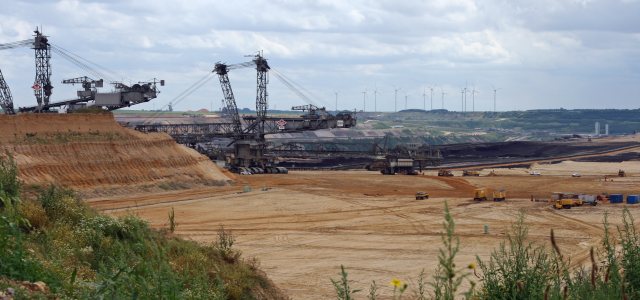Reports on German coal mining sometimes depict the destruction of villages as something new – and almost always as an ironic new outcome of the Energiewende. In reality, it’s a continuation of a century’s business as usual. And German citizens are not the defenseless anti-coal victims they are portrayed to be. In reality, it’s not easy to convince local communities affected by mining that renewables are a better option. Craig Morris investigates.

Surface coal mining is part of Germany’s contemporary energy landscape. But it isn’t the result of the Energiewende. (Photo by Bert Kaufmann, CC BY 2.0)
Often, foreign articles about coal mining in Germany make it sound like the country has a sudden hunger for coal:
- “Germany plans to raze towns for brown coal” (National Geographic)
- “Green Germany returning to brown coal, villages in limbo” (Mining.com)
- “Germany’s coal mines swallow entire towns” (Slate.com)
- “This town was almost swallowed by a coal mine” (Mother Jones)
In the Mother Jones article – which was well researched (the journalist visited Germany with funding from the Heinrich Böll Foundation, which also hosts this website) – we read of apparently defenseless German citizens being forced to leave their “little bit of paradise,” as one remaining resident calls her garden.
These journalists should not only talk to the last holdouts in these villages, but also to the people who have already left; none do. In fact, not everyone is unhappy to leave. Coal companies in Germany come in and buy up houses at above-market rates. Neighboring communities develop new neighborhoods to absorb the influx. People thus get new apartments, with the coal company paying for the move – and additionally chipping in tens of thousands of euros. For every person who defends their “little bit of paradise,” there is a neighbor who is “glad to get out of this dump.”
American journalists come over to Germany expecting to find a brutal corporate world that rides roughshod over citizenry – because that’s what they know from home; see this recent article in the New Yorker on the situation in West Virginia, for instance.
“I want my children and grandchildren to be able to take a shower and not feel that they’re going to start lighting up.”
– John Raney, retired NASA engineer, The New Yorker
They find, however, a country where a single pig farmer can hold up construction of a giant 80% completed coal plant in which a billion euros had already been invested, so coal firms in Germany try to be as nice to the public as they can. Areas with coal mines in the US and Germany have something in common, however: they tend to be economically depressed. Clearly, low energy prices (West Virginia has some of the lowest power rates in the US) do not lead to economic growth, as is commonly argued.
In both countries, the coal sector promises jobs. Germany is phasing out its hard coal mines (but not its lignite fields). In a process called “structural change” (Strukturwandel), these miners are to be given jobs in other sectors. But nowhere has it been possible to provide all of these miners with new jobs in green energy at home, for instance. Many of them have to move elsewhere to find work. One of the people quoted in numerous articles on this issue is the European Climate Foundation’s Communications Director for Germany, Carel Mohn. I have spoken with him before about something foreign journalists apparently never think to ask: how hard it is to convince local communities to oppose coal power? After all, if coal doesn’t stay, these people will largely be out of work or have to move elsewhere to get jobs.
I contacted Mohn for this report, and this is what he had to say on the matter:
“Each coal mining region needs to find its own pathway to phase out mining. For local politicians that is a tough sell. Many residents will not want to hear that an economic activity such as mining needs to come to an end – particularly when these jobs provide excellent social benefits and are well-paid.”
So there you have it – contrary to all of these international reports, getting local communities to oppose coal can be a hard sell. Most of all, the issue divides communities. Long before buildings are destroyed, the debate over whether to move or not poisons relations between previously amicable neighbors.
Craig Morris (@PPchef) is the lead author of German Energy Transition. He directs Petite Planète and writes every workday for Renewables International. Also see the report The German Coal Conundrum: The status of coal power in Germany’s energy transition written by Arne Jungjohann and Craig Morris. All graphics can be downloaded here. Graphics by Thomas Gerke.